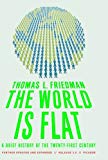
The World Is Flat is a book by Thomas Friedman discussing the trends of globalization in the 21st century. Friedman describes himself as a "free-trader," arguing in favor of the rapid shifts towards a more interconnected economic world after the fall of the USSR as a result of the Internet, computers, outsourcing and workflow software. Friedman also presents his controversial Dell Theory of Conflict Prevention: that corporations' increased dependency on foreign labor and resources will prevent armed conflict.
We begin by examining the U.S Olympic Basketball Team’s unexpected loss at the 2004 Games as an example of our complacency as the rest of the world is learning and catching up in areas we are used to dominating. An interview with Shirley Ann Jackson, 2004 President of the American Association for the Advancement of Science, demonstrates that a quietcrisis is happening slowly but surely as multiple and complex forces are at work creating the perfect storm; demographic, political, social, cultural, economic, etc., that could lead to America falling behind in innovation, science and technology. We explore the dirty little secrets that no one istalking about – a lack of highly skilled scientists and engineers, disinterest in math and science by our younger population, lack of ambition as television and video games take over, an outdated basic education system, lack of funding for research, lack of infrastructure as we focus on war and other countries focus on developing sustainable and innovative business. Friedman explores the differences between different country’s educational systems with Bill Gates and ultimately poses the question, why are we so focused on idolizing Britney Spears when competing countries are idolizing BillGates?
Friedman contemplates The“Innovate America” Report, a well-meaning document ignored by the President as he chased his own agenda – and wonders whether China will beat us to the implementation of our own innovation. He sums up the chapter with a call to action to kick-start the long process of preparing ourselves for the future into motion before we are literally left behind.
Already have an account? Log In Now